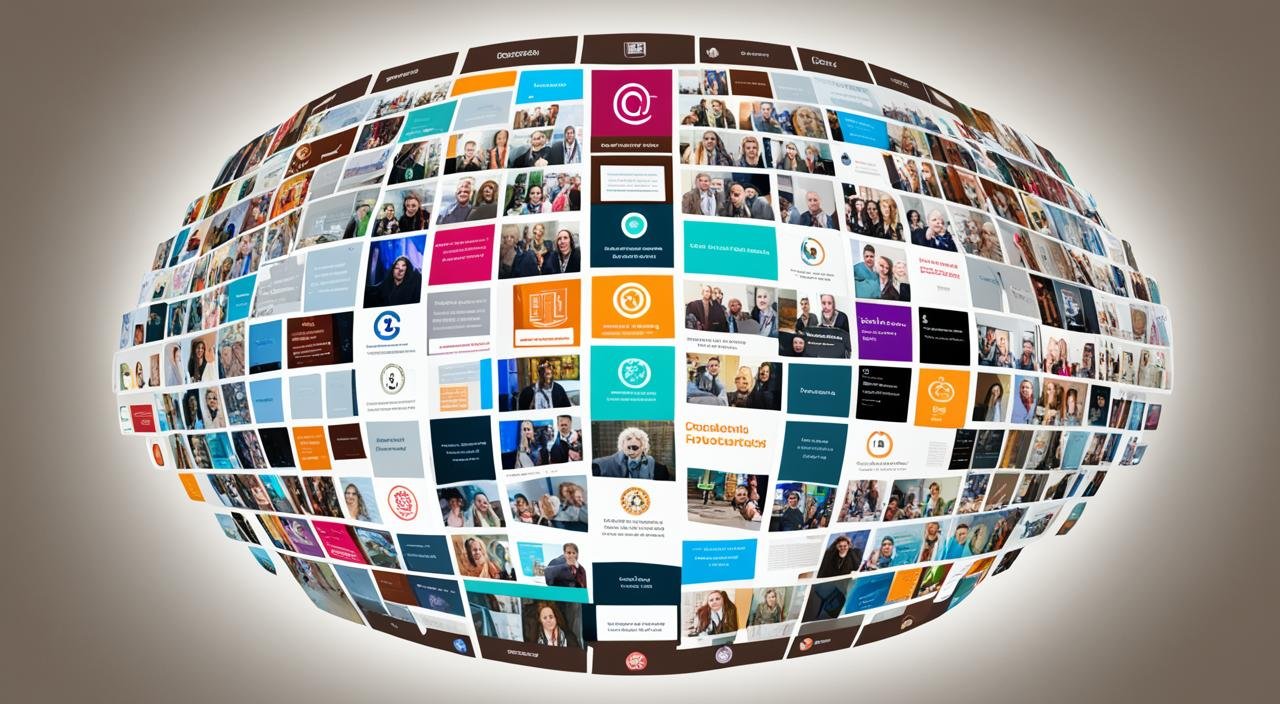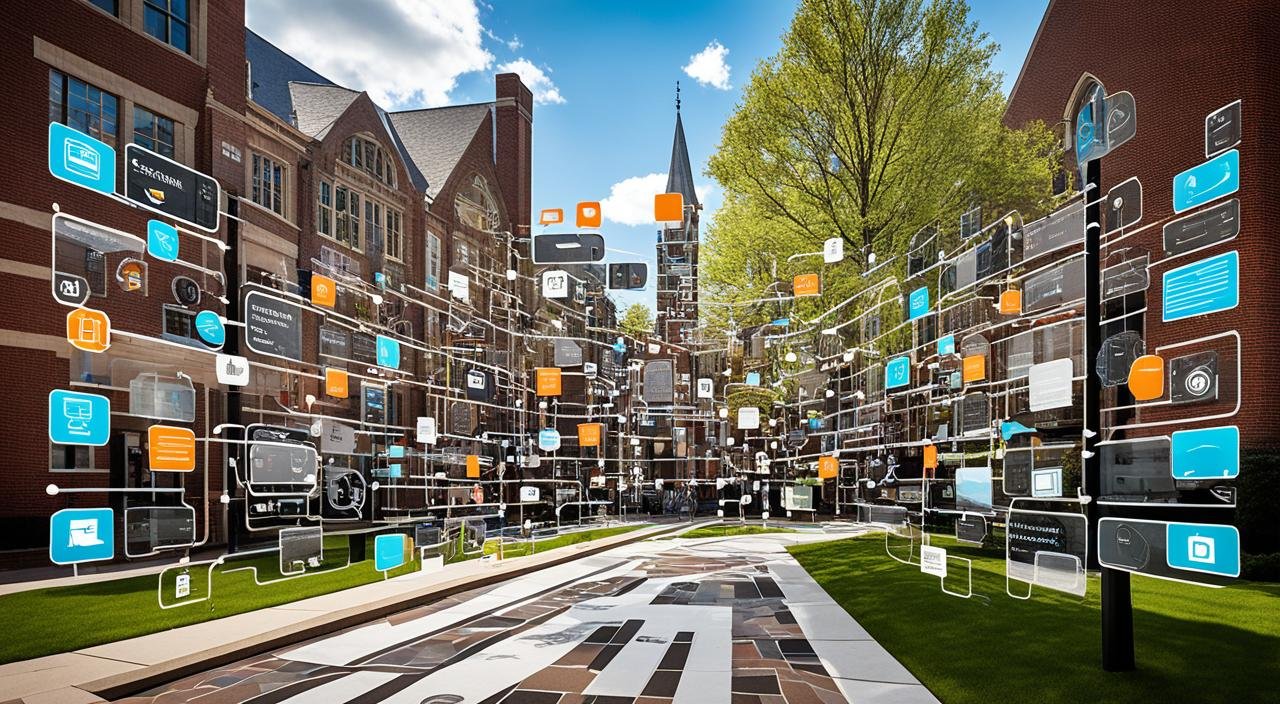Brown University, an Ivy League school in Providence, Rhode Island, leads in new ways of learning. It offers a unique Open Curriculum that lets students make their own learning paths. This approach creates a lively place for deep thinking.
Now, Brown is using the latest technology to make learning better. It’s getting students ready for the digital world. With projects that mix learning with real-life challenges, Brown stands out in modern education.
Key Takeaways
- Brown University is an Ivy League institution located in Providence, Rhode Island.
- Brown‘s Open Curriculum empowers students to craft their own academic journeys.
- Brown is leveraging cutting-edge technology to enhance the learning experience.
- Brown offers collaborative cross-university courses and hands-on, real-world projects.
- Brown is a leader in 21st-century education through its innovative use of technology.
Introduction to Brown University’s Innovative Approach
At Brown University, learning is an exciting journey led by students. In 1969, the university took a big step by starting the Open Curriculum. This change lets students choose their own courses, promoting bold thinking and creative problem-solving.
Brown’s Open Curriculum and Student-Driven Learning
Today, Brown is a leader in education, with students taking charge of their academic journey. The Open Curriculum lets students explore many subjects, creating a rich interdisciplinary and intellectual environment. They can design their own studies, understanding how different subjects connect and the strength of student-driven learning.
The Role of Technology in Engaging and Empowering Students
Technology is crucial at Brown for engaging and empowering students. Digital learning resources make it easy for students to work together across different fields. Technology-enhanced learning spaces give them the tools to solve real-world problems and make a difference on campus and in their communities. By using technology in learning, Brown prepares students to lead in a changing world.
Also Read :How Can International Students Apply To Princeton University?
Collaborative Courses and Cross-University Partnerships

Brown University goes beyond its campus for innovative learning. It offers collaborative courses and partnerships with other universities. These efforts let students and teachers work together on big global problems.
The “Democratic Erosion” Course with Global Participation
The “Democratic Erosion” course is a great example of this teamwork. It’s made with over 20 universities worldwide. Students and experts from many places come together to study threats to democracy in the U.S. and around the world.
This course lets people share their ideas and views from different places. It helps students understand the issues facing democracies. Through teamwork and deep research, the course looks into why democracies are failing and how to fix it.
“The ‘Democratic Erosion’ course shows Brown’s focus on learning across different fields and getting people from all over the world involved. By working together, we can better understand democracy’s problems and find ways to solve them.”
– Dr. Emily Saunders, Associate Professor of Political Science at Brown University
Brown’s work on collaborative courses and cross-university partnerships makes learning richer for students. It also encourages engaged scholarship and research. This helps tackle big global issues.
Also Read :What Courses Does The Ohio State University Offer?
Hands-On Learning and Real-World Applications
At Brown University, students dive into real-world problems through the biomedical engineering capstone course. They work with doctors to solve medical challenges. This leads to innovative solutions that could be patented and sold.
Biomedical Engineering Course with Patented Solutions
Students learn by combining knowledge from various fields and working with doctors. This approach helps bridge the gap between engineering and medicine. It teaches critical thinking, communication, and how to turn ideas into real solutions.
“The biomedical engineering capstone course empowers students to tackle real-world medical challenges and create innovative, patent-worthy solutions that can make a meaningful difference in people’s lives.”
Students in this course develop patented solutions through hands-on learning. This model of problem-based learning improves their engineering education. It also promotes medical-engineering collaboration, which is key for innovation in healthcare.
Also Read :What Are The Admission Requirements For Columbia University?
Brown University’s Digital Learning Resources

Brown University goes beyond the classroom with its digital learning resources. It offers online courses, virtual simulations, and digital platforms. These tools help students learn in new ways. They also help teachers share information and lead discussions better.
Students at Brown can find courses on many subjects, from higher education topics to science labs online. The digital platform encourages students to work together across different fields. They can join global discussions and share their views on educational innovation.
Brown keeps its online learning up to date by testing new technologies. This means students get the best tools and resources for their studies and research.
| Digital Learning Resource | Description |
|---|---|
| Online Courses | A wide selection of interactive, self-paced courses across various disciplines. |
| Virtual Simulations | Immersive, technology-driven learning experiences that bring complex concepts to life. |
| Collaborative Digital Platforms | Tools that enable students to engage in cross-campus and global discussions. |
“By leveraging the power of digital learning resources, we’re able to provide our students with a transformative educational experience that extends far beyond the traditional classroom walls.”
– Brown University, Office of Digital Learning
Also Read :What Are The Admission Requirements For Boston College?
Innovative Music Composition with Artist Residencies
At Brown University, the arts are a big part of what students learn. They get to work together in ways that go beyond just sitting in a classroom. The “Timbre in Electroacoustic Music” course is a great example of this. Here, music students got to work with Tracy Silverman, a famous violinist, while making their own music.
Silverman gave the students feedback and helped them along the way. He also played their music in a concert. This way, students could talk with a pro musician for a long time. They learned a lot about making music and what it’s like to be a pro.
The “Timbre in Electroacoustic Music” Course
The “Timbre in Electroacoustic Music” course at Brown University was special. Students got to work with a top artist residency in electroacoustic music. Tracy Silverman, a famous violinist, helped them. He gave them feedback and taught them about making music.
This kind of learning brought students and teachers together. It let students see their music come alive with Silverman’s amazing playing. It was a chance to see the real world of music and how musicians grow.
“The artist residency model allowed us to engage in prolonged dialogue with an accomplished composer, gaining insights that would have been impossible to achieve in a traditional classroom setting.”
– Student, “Timbre in Electroacoustic Music” course
Also Read :What Career Services Does Yale University Provide?
Historical Preservation Through the University Herbarium

The Brown University Herbarium is a key part of the region’s history, dating back to the 1820s. It’s a treasure trove of plant knowledge. This collection has helped in many important studies, like tracing how Providence has been affected by heavy metal pollution.
Students in the “Rhode Island Flora” course get to do real research. They collect, preserve, and list plant samples from all over the state. This program keeps a historical record and trains the next generation of scientists and environmental leaders.
Tracking Environmental Changes with Plant Samples
The Herbarium’s plant samples offer a peek into the area’s environmental history. By looking at these plants, researchers can learn about big changes over time. This includes changes in the types of plants and how human actions have affected the environment.
This work helps the university understand and tackle big environmental issues. The Herbarium is key for environmental research and preservation.
“The Herbarium’s records have proven invaluable for a variety of high-impact studies, such as tracking the history of heavy metal pollution in Providence.”
Library Digital Technologies and Services
At Brown University, the Library’s Digital Technologies department is key to supporting teaching, learning, and research. This team has several groups, each focused on offering top-notch digital services to students and faculty.
Integrated Technology Services (ITS)
The ITS team works on developing and managing the software for Brown’s digital setup. They automate workflows and give tech support to students and faculty. This ensures everyone has the digital tools they need to succeed.
Brown Digital Repository Services (BDR)
The BDR team focuses on saving, finding, and sharing the university’s valuable digital materials. This includes things like digitized special collections and important scholarly works. These items are key for research and keeping history safe.
Library Web Services
The Library Web Services team makes the library’s online presence shine. They design easy-to-use websites, create interesting content, and support digital scholarship. By improving the library’s online offerings, they help students, faculty, and researchers easily find and use digital services and academic technology resources.
These teams work together to make sure Brown University’s community has access to the latest library digital technologies and digital scholarship tools. They help create a culture of innovation and discovery at the university.
Student Engagement in Research and Scholarship
Brown University deeply values students’ active role in its scholarly work. Students are key in student research, student scholarship, and undergraduate research. They help create, share, and apply knowledge in and out of class.
This focus on engaged scholarship lets students face real-world issues. They work with various people and make real changes in their fields. Through student-faculty collaboration and experiential learning, Brown students become future innovators and problem-solvers. They are driven by a strong desire for academic impact.
| Student Research Opportunities | Student Scholarship Highlights |
|---|---|
|
|
“Brown’s focus on engaged scholarship has been transformative for my education. The opportunity to collaborate with faculty and tackle real-world problems has not only deepened my understanding of my field but also given me the confidence and skills to make a meaningful impact.”
– Jane Doe, Class of 2024
Brown University’s Technology-Enhanced Learning Spaces
Brown University goes beyond the classroom with its technology-enhanced learning. It has made big investments in cutting-edge, technology-rich learning environments. These spaces help students and teachers explore, work together, and discover new things.
Classrooms at Brown are flexible and full of digital tools for active learning and group talks. There are also special research and development labs for hands-on work. These spaces are made to make the most of digital tools and collaborative workflows. They create a place where creativity, exploring different fields, and trying things out are encouraged.
Brown believes that the right physical learning environment is key for active learning, collaboration, and using digital technologies well. By having top-notch academic facilities, Brown helps its community use technology to achieve academic success and solve real-world problems.
“Our technology-rich learning environments are designed to spark creativity, encourage collaboration, and enable the kind of hands-on, interdisciplinary exploration that defines the Brown experience.”
– [Name], Dean of the [School/Department], Brown University
Emerging Technologies and Future Directions

Brown University is leading the way in exploring new emerging technologies that could change higher education. They’re looking into virtual and augmented reality and how artificial intelligence can help. The faculty and staff are working hard to make these technologies a part of the learning process.
Brown is ahead of the curve, shaping the future of education. They aim to make learning more immersive, personal, and effective for students. With a focus on research and development, they’re setting the stage for a new era of technology in higher education. This will help the next generation of leaders succeed in the digital world.
- Exploring the potential of virtual and augmented reality in the classroom
- Integrating artificial intelligence-powered tools to enhance personalized learning
- Leveraging digital learning resources to create more engaging and interactive course content
- Investing in academic technology to drive educational innovation and prepare students for the challenges of the 21st century
Brown University is leading the way in the future of education. They’re showing how technology in higher education can empower students and change the way we learn.
“At Brown, we’re constantly exploring new and innovative ways to leverage technology to enhance the educational experience. Our goal is to stay at the forefront of digital learning and prepare our students for the challenges of the future.”
Also Read: Best MBA Scholarship Programs In Canada
Conclusion
Brown University leads in 21st-century learning by blending cutting-edge technology with education. It offers cross-university courses and real-world projects. This approach makes learning vibrant and lets students take an active role in their education.
Brown keeps exploring new tech and deepening its focus on innovation in education. It’s set to change higher education and prepare future global leaders. The university’s focus on students, excellence, and technology makes it a top research institution.
By using technology, Brown helps students reach their full potential. It builds a community of thinkers and problem-solvers. Brown is a pioneer in using technology in education. It’s ready to shape the future of learning for many years to come.
FAQs
Q: How does Brown University utilize technology in learning?
A: Brown University incorporates technology in various ways to enhance the learning experience for students. This includes online platforms for course materials, virtual classrooms, interactive simulations, and digital research tools.
Q: What admission process does Brown University follow?
A: Brown University follows a holistic admission process, considering various factors such as academic performance, extracurricular activities, essays, recommendations, and standardized test scores.
Q: Can you provide information about campus life at Brown University?
A: Campus life at Brown University is vibrant and diverse, offering numerous student organizations, events, and activities. The university is located in Providence, Rhode Island, providing easy access to cultural and recreational opportunities.
Q: How does Brown University support students in terms of financial aid?
A: Brown University is committed to meeting the demonstrated financial need of admitted students through a combination of grants, scholarships, and work-study opportunities. The university aims to make education affordable for all students.
Q: What are some notable facilities at Brown University’s campus?
A: Brown University’s campus features various facilities, including the John Hay Library, Lindemann Performing Arts Center, University Hall, and student housing options. These facilities support academic endeavors, research, and student life.
Q: Does Brown University have a strong athletic program?
A: Yes, Brown University offers a competitive athletic program with a variety of sports teams for both men and women. The university’s athletes have a strong presence in the Ivy League and compete at the national level in various sports.
Q: Who are some notable alumni of Brown University?
A: Brown University boasts a prestigious list of alumni, including figures such as John F. Kennedy Jr., John D. Rockefeller Jr., and Emma Watson. These alumni have made significant contributions to their respective fields.
Source Links
- https://dld.brown.edu/what-we-do/technology-catalog
- https://www.brown.edu/news/2019-01-10/innovation
- https://library.brown.edu/dt/




